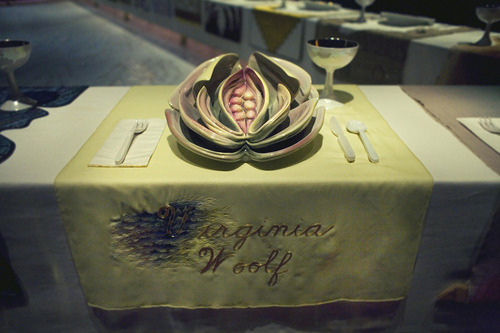Making the Intangible Concrete
In her poetic writing, Virginia Woolf has the habit of making intangible things or concepts entirely concrete, weighty and real. She attaches feelings to objects, intensely describing their creation or destruction. In Mrs. Dalloway, Peter Walsh attempts to describe the internal psychology of Clarissa and imagines her holding a concrete "life" in her hands:
For she was a child, throwing bread to the ducks, between her parents, and at the same time a grown woman coming to her parents who stood by the lake, holding her life in her arms which, as she neared them, grew larger and larger in her arms, until it became a whole life, a complete life, which she put down by them and said, "This is what I have made of it! This!" And what had she made of it? What, indeed? (36).
He describes her growing life, increasing in size and validity by the second, as entirely concrete. As a reader, I imagine a glowing orb of sorts placed in offering before her parents. Here, Virginia Woolf connects the theoretical desire for approval and the physical act of offering seamlessly. The effect is stunning.
In another example, Woolf describes Clarissa in contemplation of her role as a hostess. In this internal exploration, she directly addresses "life" much like a person. Woolf writes, "That's what I do it for," she said, speaking aloud, to life" (107). By making it physically real she is addressing "life" head-on, bringing this confrontation into focus amidst the otherwise wandering novel.
Clarissa, in the process of rediscovering the meaning of her parties, begins to feel the presence of something physical. Woolf articulates the sensation of self-discovery with the description: "Since she was lying on the sofa, cloistered, exempt, the presence of this thing which she felt to be so obvious became physically existent; with robes of sound from the street, sunny with hot breath, whispering, blowing out the blinds"(107). In rational terms, these suddenly very poignant, seemingly erratic descriptions ("robes of sound," "hot breath," & "whispering") do not make sense, but in a poetic, fragmented way, they very accurately describe the sensation that something is being realized, that something is becoming real.
Woolf employs the same technique when articulating Clarissa's attachment to her acquaintances. After meeting, she proceeds throughout her day and the connections she describes as "webs" deteriorate:
And they went further and further from her, being attached to her by a thin thread (since they had lunched with her) which would stretch and stretch, get thinner and thinner as they walked across London; as if one’s friends were attached to one’s body, after lunching with them, by a thin thread, which (as she dozed there) became hazy with the sound of bells, striking the hour or ringing to service, as a single spider’s thread is blotted with rain-drops, and, burdened, sags down (99).
This physical, web description allows the reader to very acutely understand the sensations of intense stretch and eventual separation between individuals in the novel. We can equate something we've physically beheld (the stretching of material) to something that we can emotionally feel (resistance to social separation).
In yet another example, Lady Bruton describes her passion of "emigration," and makes this sensation physical. She reflects, "It may be Emigration, it may be Emancipation; but whatever it be, this object round which the essence of her soul is daily secreted, becomes inevitably prismatic, lustrous, half looking-glass, half precious stone; now carefully hidden in case people should sneer at it; now proudly displayed" (96). Here, Lady Bruton describes the meaning of her life, "the essence of her soul," in a concrete way. It leaks from a glass-like prism or stone. Perhaps this is meant to suggest that the meaning of her life is suppressed, secret or restricted, leaking from confines. The stone container is at once hidden and displayed, potentially suggesting her own ability to come to terms with "the essence of her soul." Whatever the meaning, this description is incredibly poetic, an image that begs the reader to her own interpretation.
Woolf employs this descriptive method again when Peter Walsh reflects about his age: "The compensation for getting old was simply this; that the passions remain as strong as ever, but one has gained - at last! - the power which adds the supreme flavour to existence - the power of taking hold of experience, of turning it round slowly, in the light" (69). Here, Woolf makes experience solid, something to be held within one's own hand. She suggests that the aged individual can possess it fully, can see experiences with nuanced understanding, in different shades of light.












